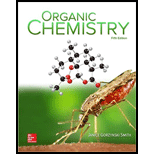
Concept explainers
(a)
Interpretation: The given products is to be labeled as
Concept introduction: Diene is a hydrocarbon that contains two
(b)
Interpretation: The given products are to be labeled as kinetic and
Concept introduction: Diene is a hydrocarbon that contains two
(c)
Interpretation: The reason as to why addition of
Concept introduction: The reaction of hydrogen halide with
Electrophilic addition reactions are those in which breaking of pi bond take place to form new sigma bond.
Want to see the full answer?
Check out a sample textbook solution
Chapter 16 Solutions
Package: Organic Chemistry with Connect 2-year Access Card
- What other alkene is also formed along with Y in Sample Problem 9.3? What alkenes would form from X if no carbocation rearrangement occurred?arrow_forwardWhich alkene in each pair is more stable?arrow_forwardThe use of curved arrows is a powerful tool that illustrates even complex reactions. a.Add curved arrows to show how carbocation A is converted to carbocation B. Label each new σ bond formed. Similar reactions have been used in elegant syntheses of steroids. b.Draw the product by following the curved arrows. This reaction is an example of a [3,3] sigmatropic rearrangement, as we will learn in Chapter 25.arrow_forward
- Addition of HCl to alkene X forms two alkyl halides Y and Z. (A) Label Y and Z as a kinetic or thermodynamic product and explain why. (B) Explain why the addition of HCl occurs at the exocyclic C=C, rather than the other C=Carrow_forwardWhat other alkene is also formed along with Y in Sample Problem 9.3 (Attached) ? What alkenes would form from X if no carbocation rearrangement occurred?arrow_forwardWhich nucleophile would prefer simple addition over conjugate addition? CH3MgBr NaCN CH3CH2NH2 (CH3CH2)2CuLiarrow_forward
- 1. Which among these would be the most stable carbocation?a. Allylicb. Vinylicc. Primaryd. Secondary2. What is the primary reason for the stability of tertiary carbocations?a. Free rotationb. Resonancec. Hyperconjugationarrow_forwardCan someone explain why the answer is D and not C. I need help with the stereochemistry. Thank youarrow_forwardMarkovnikov Addition requires carbocation formation. T or F Markovnikov addition refers to both regiochemistry and stereochemistry. T or F Both oxymercuration-demercuration and hydroboration-oxidation both occur with a concerted syn addition as their first step. T or F Stereochemistry and regiochemistry are important when choosing from the 3 different sets of hydration reagents. T or Farrow_forward
- Consider a reaction where cis-but-2-ene is treated with sO followed by NaHSO/H, O. Draw the structure of one product that is formed in the reaction, including correct stereochemistry.arrow_forwardClassify each reaction as an electrocyclic reaction, a cycloaddition, or a sigmatropic rearrangement. Label the σ bonds that are broken or formed in each reactionarrow_forwardDraw the energy diagram for the reaction below showing the transition state (s)arrow_forward
 Organic Chemistry: A Guided InquiryChemistryISBN:9780618974122Author:Andrei StraumanisPublisher:Cengage Learning
Organic Chemistry: A Guided InquiryChemistryISBN:9780618974122Author:Andrei StraumanisPublisher:Cengage Learning
